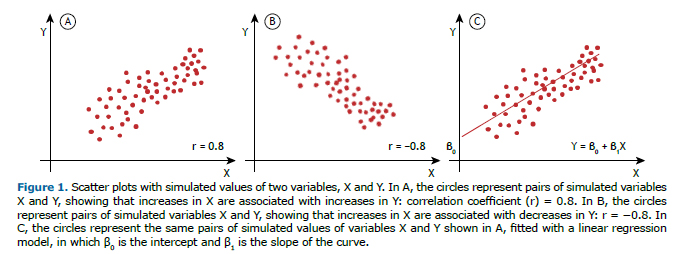When the goal of a researcher is to evaluate the relationship between variables, both correlation and regression analyses are commonly used in medical science. Although related, correlation and regression are not synonyms, and each statistical approach is used for a specific purpose and is based on a set of specific assumptions.
When testing the correlation between two variables, we use the correlation coefficient (r) to quantify both the strength and the direction of the relationship between two numeric variables, the results ranging from −1 to 1. When r = 0, this indicates that there is no linear relationship between the two variables; when r = 1, this indicates a perfect positive relationship between the two variables and implies that as the value of one variable increases, the value of the other one also increases (Figure 1). When r = −1, this indicates a perfect negative relationship and implies that as the value of one variable increases, the value of the other one decreases. In most cases, the strength of the relationship between the variables is not perfect; therefore, r is not exactly 1 or −1. The strength of a correlation is commonly interpreted as weak (r < ±0.4), moderate (r ranging from ±0.4 to ±0.7), and strong (r > ±0.7).(1) Lastly, we highlight that when correlation is used as a statistical approach, the data should be derived from a random sample; the variables should be continuous; the data should not include outliers; each pair of variables need to be independent(1); and the correlation does not necessarily imply a cause-and-effect relationship.

Regression is indicated when one of the variables is an outcome and the other one is a potential predictor of that outcome, in a cause-and-effect relationship. If the outcome is a continuous variable, a linear regression model is indicated, and, if it is binary, a logistic regression is used. Regression also quantifies the direction and strength of the relationship between two numeric variables, X (the predictor) and Y (the outcome); however, in contrast with correlation, these two variables are not interchangeable, and correctly identifying the outcome and the predictor is key. Regression models additionally permit the evaluation of more than one predictor variable, another important difference from correlation analysis.(2)
Regression is a linear mathematical model represented by the equation Y = β0 + β1X (Figure 1). When the value of X (the predictor) is zero, the value of Y is β0 (the line intercept), and β1 is the slope, which gives us information of the magnitude and direction of the association between X and Y, similarly to the correlation coefficient. When β1 = 0, there is no association between X and Y. When β1 > 0 or β1 < 0, the association between X and Y is positive or negative, respectively. Important assumptions of linear regression are normality and linearity of the outcome variable, independence between the two variables, and equal variance of the outcome variable across the regression line.(2)
In conclusion, when evaluating the relationship between two variables, we need to understand the differences between correlation and regression and choose which statistical test is better to answer the research question.
REFERENCES1. Schober P, Boer C, Schwarte LA. Correlation Coefficients: Appropriate Use and Interpretation. Anesth Analg. 2018;126(5):1763-1768. http://doi:10.1213/ANE.0000000000002864
2. Kutner MH, Nachtsheim CJ, Neter J, Li W. Simple Linear Regression. In: Kutner MH, Nachtsheim CJ, Neter J, Li W. Applied linear statistical models. 5th ed. New York: McGraw-Hill; 2005. p. 1-87.


